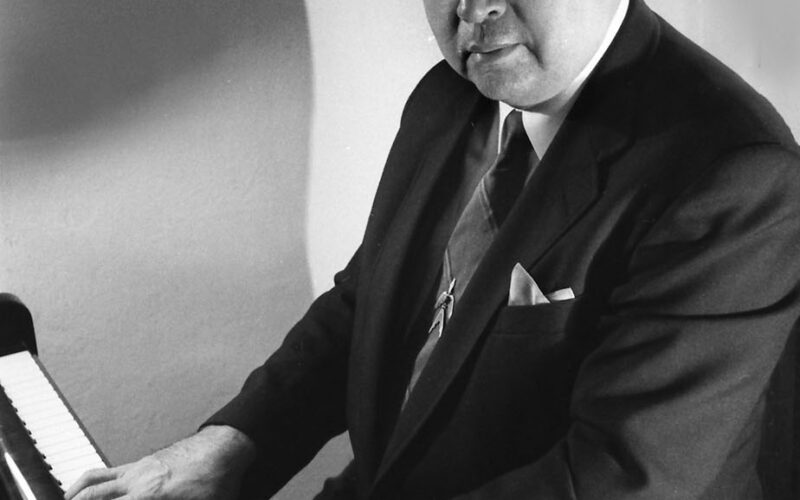BECCA MARTIN-BROWN
bmartin@nwaonline.com
Louis Wayne Ballard — or “Honga-no-zhe,” meaning “Grand Eagle” in Quapaw — was born on July 8, 1931, in Devil’s Promenade, Okla., near Miami. His mother was Quapaw; his father Cherokee. At 6, he was sent to the Seneca Indian Training School, where the goal was to assimilate him into white American culture.
Ballard’s story of cultural indoctrination is unfortunately not unusual for the time when he grew up. What makes it notable is his resistance — he continued to speak Quapaw, despite being punished for doing so; in 1962, he became the first Native American to receive a graduate degree in composition from the University of Tulsa; and in his work as a composer, he made a lifelong commitment to keeping his musical roots alive.
“For one of his early educational assignments, he arranged a traditional Ponca Indian melody in the style of Chopin and Rachmaninoff,” says his granddaughter, Simone Ballard, on a new website, lwballard.com. And that might be said to have set his trajectory as the “father of Native American composition.”
Ballard died in 2007, but his music is enjoying a revival, thanks to his granddaughter’s efforts and the Fort Smith Symphony, which will perform an evening of Ballard’s music April 22 — and then record it for Naxos Records.
“An orchestral concert like this rarely happens anywhere. I wouldn’t say it’s a once in a lifetime experience, but it kind of is,” says John Jeter, the symphony’s music director and conductor. “The music is terrific. We will be performing two works, ‘Fantasy Aborigine No. 3’ and ‘Devil’s Promenade,’ that I think after the recording is released will become standard repertoire for orchestras everywhere.
“We are [also] performing his complete ballet music to ‘The Four Moons,’ which celebrates the legacy of Shawnee, Choctaw, Osage and Cherokee ballerinas,” Jeter adds. “Ballard’s first successful orchestral piece, ‘Scenes from Indian Life’ from 1966, will be performed with ‘Feast Day,’ a work he added to ‘Scenes from Indian Life’ 30 years later. ‘Incident at Wounded Knee’ is also on the program, which is perhaps his most well-known work and represents a much more contemporary and edgy style of composition.
“After the Symphony performs in concert, the following two days will be spent recording the music for Naxos Records. Naxos is the leading classical music label in the world today, and we are grateful for their interest in recording Ballard’s music,” Jeter adds. “It’s really the first orchestral recording of its kind ever done as far as we know, a recording dedicated to a historic Native American concert composer — and Ballard is considered the first.”
Jeter says he was made aware of Ballard’s music by a member of his orchestra, Christina Giacona, who is also an expert on Indigenous music, and was assisted in the process of performing and recording it by Chickasaw composer Jerod Tate and Ballard scholar Erik Ettinger.
Of course, he says, “this entire project could not happen with the support of over a dozen wonderful sponsors. We know we can’t mention them all, but it was initial discussions and major support from the Walter O. Caldwell Foundation and ArcBest Corporation that pushed this endeavor to fruition.
“Louis Ballard is one of those wonderful composers who has a style all his own,” Jeter enthuses. “One can hear influences of Stravinsky, Ravel and Copland, but he also utilizes Native American instruments, rhythms and both original and composed Native American melodies and combines them into a wonderful style.
“I have to say that his style is very different from piece to piece,” Jeter goes on, adding that Ballard’s compositions include not only modern instruments but a number of Indigenous instruments such as an eagle bone whistle, various Indigenous drums, rattle gourds, rasp sticks and water. “He is quite a musical chameleon, which is what makes his music so special — as people will hear at the concert.”
Simone Ballard not only works in her grandfather’s memory but knew him herself, although he passed away when she was just 13.
“I remember being at camp on the Quapaw Indian Reservation during ceremonial dances with my grandfather and aunts, uncles and cousins,” she says. “I think that my trips to the tribal dances when I was younger were paramount for forming my tuned ear towards live drum rhythms, Native singing, and the specific movements that go along with everything.
“There really is no other way to input the entire experience without attending live, in my opinion,” she adds. “Recordings are good, but they don’t come close to feeling the vibrations up close from the drums and vocals.”
Before the Fort Smith Symphony performance, Ballard suggests turning to her website to understand the historical context of some of her grandfather’s compositions. But “my grandfather wrote classical music mainly for an audience that was non-Indigenous at the time, so in general there isn’t too much to ‘pre-interpret.’”
Ballard says she is “always aware that I come from a unique history and culture that developed separately from Europe,” but working with her grandfather’s legacy “marks a different era for me personally where my Native identity will be something more at the forefront — and I hope a real barrier breaker as time goes on.”
FAQ
Fort Smith Symphony:
‘Native American Legends’
WHEN — 7 p.m. April 22
WHERE — ArcBest Performing Arts Center in Fort Smith
COST — $30-$50
INFO — fortsmithsymphony.org



